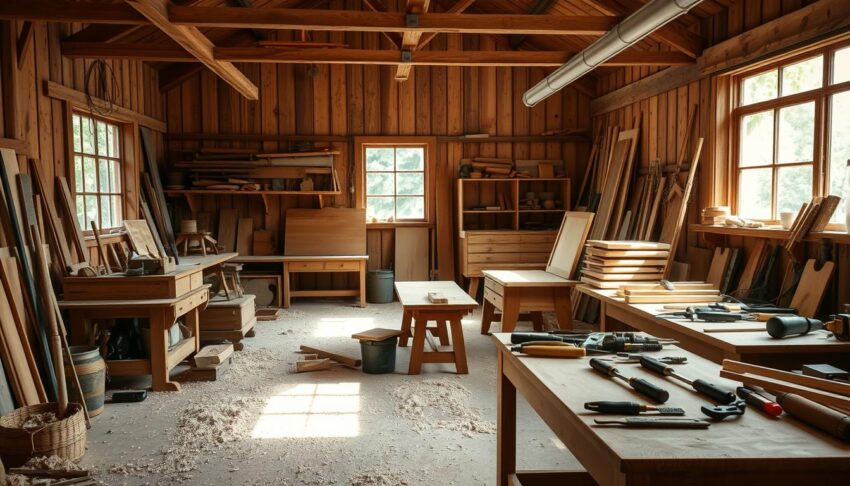I’ve always loved woodworking. The sound of a saw and the joy of making something from wood is special. It’s like a dance where your mind and hands work together.
In this guide, I’m excited to share my DIY plans for making your dream furniture. It doesn’t matter if you’re new to woodworking or have lots of experience. You’ll find joy in making your own furniture. I’ll help you from picking the right materials to adding the final touches.
Key Takeaways
- Discover the joy and fulfillment of creating custom furniture pieces
- Learn step-by-step DIY plans for woodworking projects, from beginner to advanced
- Explore the tools, techniques, and design principles to craft high-quality furniture
- Unlock your creativity and personalize your furniture with unique touches
- Gain the confidence and skills to tackle a wide range of woodworking projects
Introduction to Woodworking Projects
Start your woodworking journey and explore the world of DIY furniture. It’s perfect for both experienced woodworkers and newcomers. Woodworking projects offer a sense of accomplishment and pride in creating something unique.
Benefits of Custom Furniture
Custom furniture lets you design your space exactly how you want it. You can make furniture that fits your style and needs perfectly. Seeing your ideas come to life is incredibly rewarding.
Skills You’ll Need
Woodworking projects need various skills, from basic carpentry to detailed design. While some skills might seem hard at first, practice makes perfect. You’ll learn to measure, cut, sand, and assemble through experience and learning resources.
Tools for the Job
Having the right tools is key for good woodworking. You’ll need everything from basic hand tools to advanced power tools. The right tools are essential for creating high-quality DIY furniture.
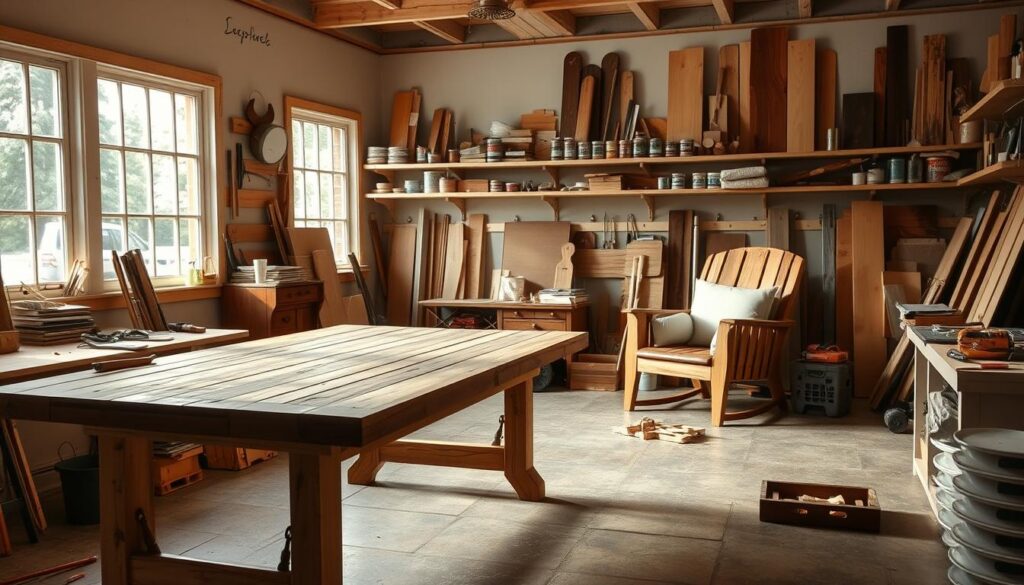
“The true joy of a handmade piece lies in the personal touch and the sense of accomplishment that comes with creating something truly unique.”
Getting Started: Planning Your Furniture Project
Starting a furniture design project is both exciting and challenging. With the right planning, you can make your dream furniture a reality. Let’s look at the key steps to begin your furniture design journey.
Choosing the Right Materials
Choosing materials is key in furniture design. Furniture design needs attention to detail and knowledge of wood types. Whether you like oak’s rich grain, maple’s smooth look, or pine’s rustic feel, picking the right material is crucial.
Designing Your Custom Piece
Let your creativity shine by designing your dream furniture. Sketch your ideas, try out wood joinery techniques, and think about function and looks. This stage is where your vision comes to life, preparing you for a successful woodworking project.
Love creating? Get the best DIY plans and tips here.
Measuring and Sizing
- Accurate measurements are key for a perfect fit and smooth construction.
- Measure the space where your furniture will go, considering the room’s look and layout.
- Decide on your piece’s size, thinking about comfort, storage, and balance.
By carefully planning your furniture project, from picking materials to precise measurements, you’re setting up for success. These steps will help you create the furniture you’ve always wanted.
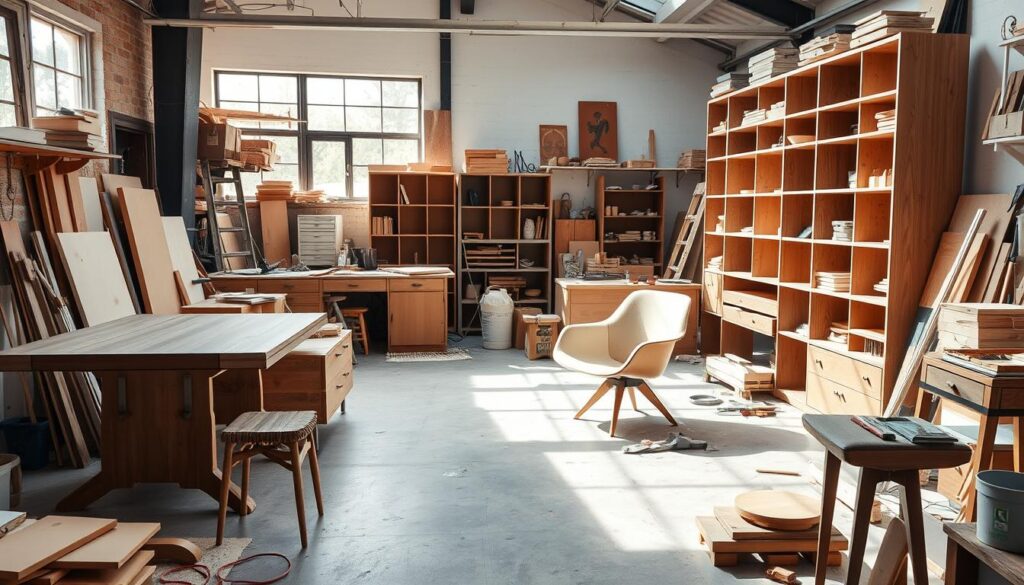
“The only limit to our realization of tomorrow will be our doubts of today.”
– Franklin D. Roosevelt
Popular Woodworking Projects for Beginners
Start your woodworking journey with these beginner-friendly projects. You can make simple shelves, cozy coffee tables, and sturdy outdoor furniture. These projects will boost your skills and add a personal touch to your home.
Simple Shelves
Shelves are great for beginners. They need just a few tools and materials but offer many design options. You can make sleek floating shelves, rustic ledges, or freestanding bookcases. These pieces are perfect for adding your own style to any room.
Coffee Tables
Making a custom coffee table is a great way to show off your style. Try using different woods like oak, walnut, or pine for a unique look. Whether you like simple designs or something more elaborate, building your own coffee table is a fun challenge.
Outdoor Furniture
- Deck Benches: Create cozy seating for your patio or deck with DIY wooden benches. You can customize the size, shape, and finish to fit your space.
- Adirondack Chairs: Make your own weatherproof Adirondack chairs using cedar or redwood. They add a classic charm to your outdoor area.
- Porch Swings: Build a handmade porch swing for relaxing afternoons and summer evenings. It’s a great way to enjoy the outdoors.
Creating custom DIY furniture is rewarding. These projects will help you learn new skills, be creative, and enjoy making something beautiful and useful.
Discover how to turn your ideas into reality with these DIY plans. Start here
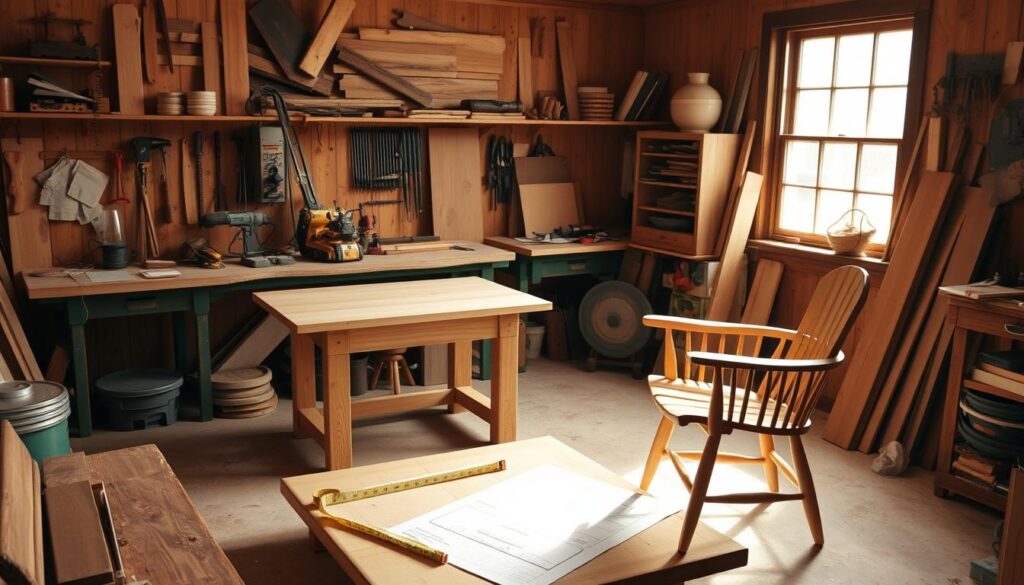
Intermediate Woodworking Projects
Now that you’re getting better at making furniture, it’s time for more challenging projects. You can build intricate dressers, side tables, bookshelves, and sturdy benches. These projects will test your creativity and skills.
Dressers and Side Tables
Making a custom dresser or side table needs a good eye for design and advanced furniture skills. These projects involve dovetail joinery, detailed drawer designs, and precise measurements. By mastering these skills, you can create beautiful pieces that are both functional and stylish.
Bookshelves
Bookshelves are great for storing and showing off your favorite books. Building a custom bookshelf lets you design it just the way you want. You’ll need to learn about dados, rabbets, and mortise-and-tenon joinery to make a strong and attractive bookshelf.
Benches
Benches are not just useful; they can also be beautiful pieces in your home. You can try different styles, like Shaker or modern designs. These projects require careful attention to detail and advanced woodworking techniques, like steam bending and mortise-and-tenon joinery.
When you start these advanced projects, be patient, precise, and always keep learning. The joy of making your own furniture is worth the effort.
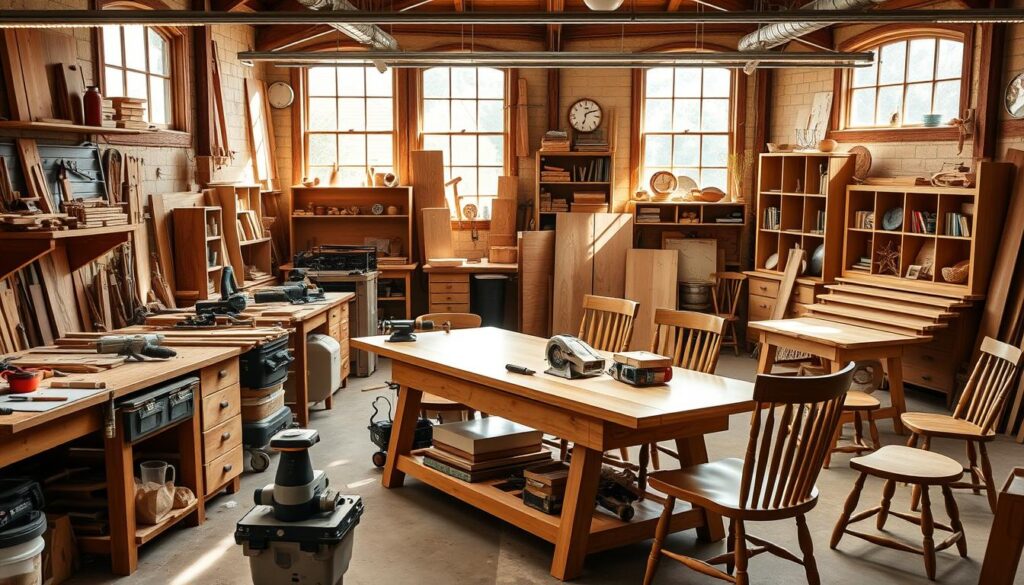
“The true joy of woodworking lies in the process of creating something tangible and lasting with your own hands.”
Advanced Woodworking Techniques
Take your woodworking to the next level by learning advanced techniques. Discover how to create stunning custom furniture with intricate joinery and professional finishing methods. These skills will elevate your projects and make them truly stand out.
Joinery Basics
Mastering wood joinery is key to making sturdy furniture. Learn about mortise and tenon, dovetail, and lap joints. These methods add beauty and strength to your custom furniture.
Finishing Techniques
The finishing process brings your projects to life. Learn how to use hand-rubbed oil finishes, lacquering, and varnishing. These techniques give your wood a smooth, high-quality look that highlights its natural beauty.
Inlay and Overlay Methods
Enhance your custom furniture with inlay and overlay techniques. Use contrasting woods, mother-of-pearl, or metals for stunning designs. These methods require precision but offer breathtaking results.
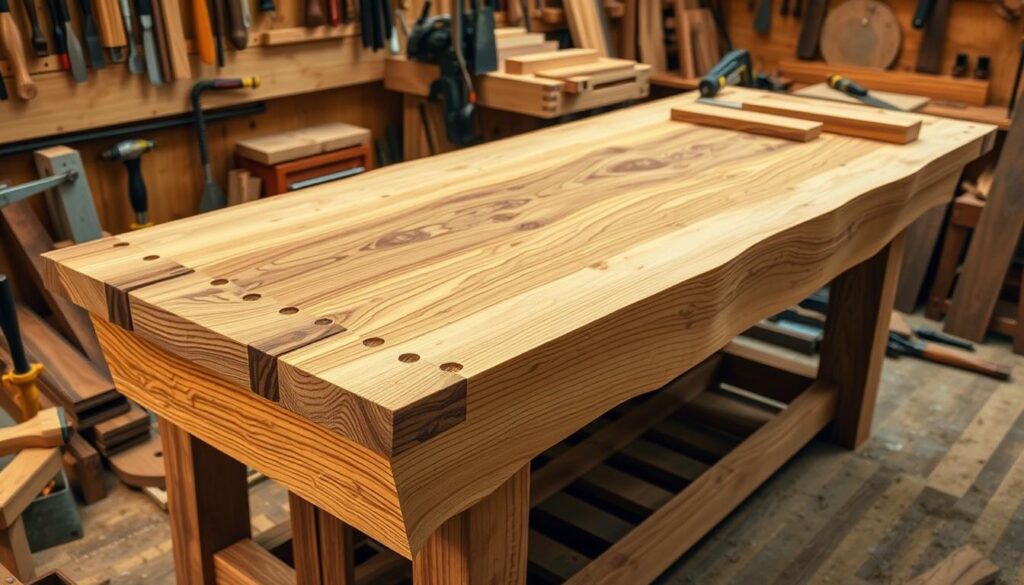
“The devil is in the details when it comes to advanced woodworking. Mastering these techniques is the key to unlocking the full potential of your custom furniture designs.”
| Joinery Technique | Description | Ideal Applications |
|---|---|---|
| Mortise and Tenon | A strong joint created by inserting a tenon (a projecting piece of wood) into a mortise (a hole or cavity). | Furniture frames, table legs, chair joints |
| Dovetail | An intricate joint formed by interlocking triangular-shaped pins and tails, creating a visually appealing and sturdy connection. | Drawers, boxes, cabinet corners |
| Lap Joint | A simple joint where two pieces of wood overlap and are secured together, often used for structural support. | Shelves, benches, outdoor furniture |
How to Build Furniture: Step-by-Step Guide
Are you ready to turn your woodworking dreams into reality? This guide will take you through building furniture, from getting supplies to finishing your pieces. You’ll learn how to make your own custom furniture.
Make your DIY dreams come true! Find out how here
Gathering Your Supplies
The first step is to get the right tools and materials. Make a list of what you need, like:
- Lumber (choose the type and size based on your project)
- Power tools (e.g., circular saw, jigsaw, drill, and sander)
- Hand tools (e.g., measuring tape, clamps, hammer, and screwdrivers)
- Sandpaper in various grits
- Wood glue and fasteners (screws, nails, or dowels)
- Finishing supplies (e.g., stain, varnish, or paint)
Construction Techniques
Now that you have your supplies, start building. Measure and cut your lumber carefully. Use joinery techniques like mortise and tenon or dovetail joints to build your furniture.
Remember to follow safety rules and use tools correctly. Try different methods to get the look and strength you want.
Sanding and Finishing
The last step is to finish your furniture. Sand the whole piece, starting with coarse sandpaper and moving to finer grits. This makes the surface smooth for finishing.
Choose a stain, paint, or varnish to enhance the wood’s beauty and protect it. Apply each layer carefully, following the instructions for the best results.
With these steps, you’re ready to make your own furniture. It will add a special touch to your home. Happy building!
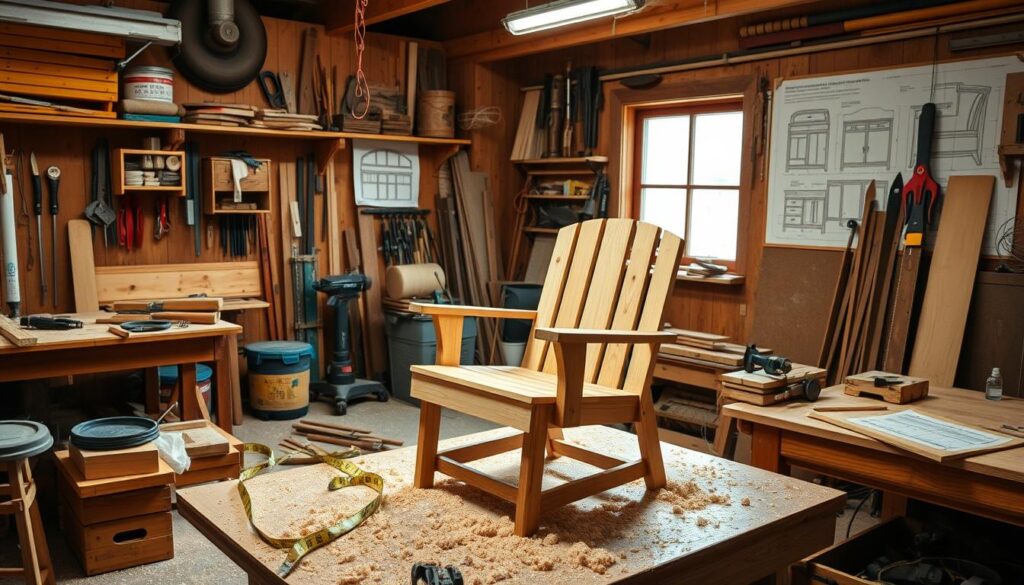
Customizing Your Furniture
Let your creativity flow and turn your furniture into unique pieces that show off your style. Whether you love making DIY furniture or just want to add a special touch to your custom furniture, there’s a world of possibilities. You can make your furniture truly stand out.
Personalizing with Stains and Paints
Try out different stains and paints to give your furniture a fresh look. You can choose from bold colors to natural tones. The right finish can change how your furniture design looks. Be bold and mix techniques to get the look you want.
Adding Unique Hardware
Make your furniture look better by picking and installing special hardware. Choose from fancy knobs to sleek handles. Look for unique pieces at flea markets, antique stores, or online. This will make your furniture look even more special.
Why buy when you can DIY? Explore incredible project plans now.
Incorporating Design Elements
Add design elements that show off your taste and personality. You could carve patterns, add decorative inlays, or use old materials. Try new things and think creatively to make your custom furniture truly unique.
“The true essence of a work of art is not in the final product, but in the journey of creating it.”
Enjoy the journey of customizing your furniture and let your creativity shine. With a bit of imagination and the right skills, you can turn any piece into a beautiful, personalized item.
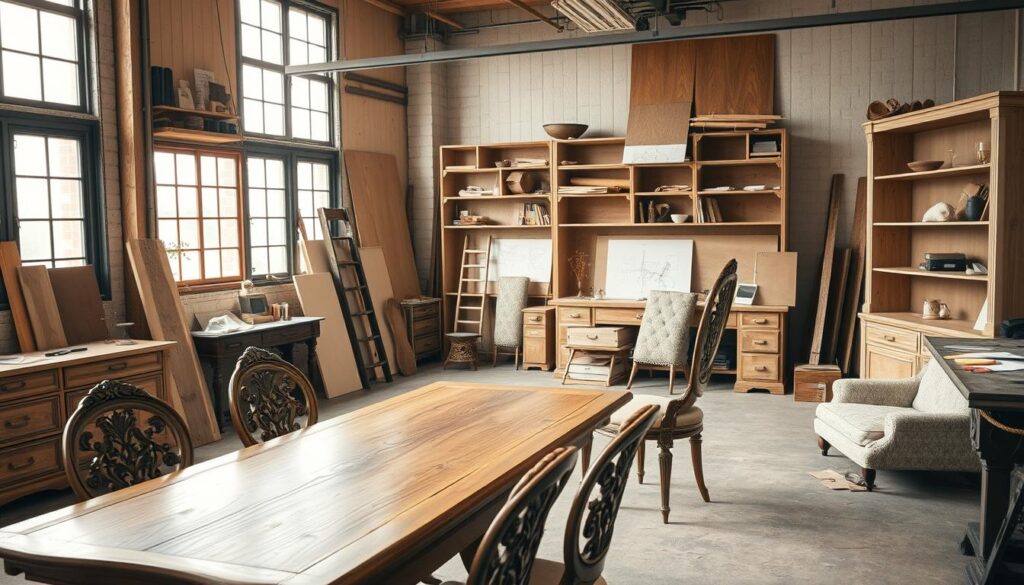
Tips for Successful Woodworking
Starting a woodworking project can be very rewarding. But, it’s key to focus on safety and follow best practices for success. As someone who loves woodworking, I’ve found that it’s not just about knowing how to use tools. It’s also about paying attention to details and keeping your tools in good shape.
Safety Precautions
Woodworking can be dangerous if you don’t take the right safety steps. Always wear safety glasses, gloves, and sturdy shoes to protect yourself. Learn how to use your tools safely and never skip important safety features. Keep your workspace clean and organized to avoid accidents.
Avoiding Common Mistakes
- Measure twice, cut once: Don’t rush when measuring and marking. Double-check your measurements to get a perfect fit.
- Pay attention to wood grain: Knowing the wood grain direction is crucial for strength and looks. Always work with the grain.
- Don’t skimp on tools: Good tools are worth the investment. Cheap tools might save money but can cause frustration and poor results.
Maintaining Your Tools
Keeping your tools in good shape is essential for their long life and performance. Always clean and store your tools right after use. Regularly sharpen or replace blades and edges. This will improve your work quality and safety.
By following these tips, you’ll be on your way to making beautiful custom woodwork that lasts. Woodworking is a journey. With each project, you’ll get better and appreciate the craft more.
Conclusion: Creating Lasting Treasures
As we wrap up our look at DIY furniture projects, I hope you’ve found joy in making your own furniture. Turning raw materials into unique pieces is rewarding. It lets you add your personal style to every item.
The Joy of Handmade Furniture
Building furniture by hand is special. You feel proud and accomplished when you see your work. Each piece shows your skills, creativity, and hard work. It becomes a treasure that adds warmth and charm to your home.
Sharing Your Creations
I suggest you show off your furniture to family and friends. Seeing their joy and appreciation will make you even happier. It might even inspire others to try DIY furniture making.
Encouraging Future Projects
Keep exploring custom furniture, wooden crafts, and DIY furniture. Each new project is a chance to learn and improve. You’ll create more cherished items for your home and loved ones.


